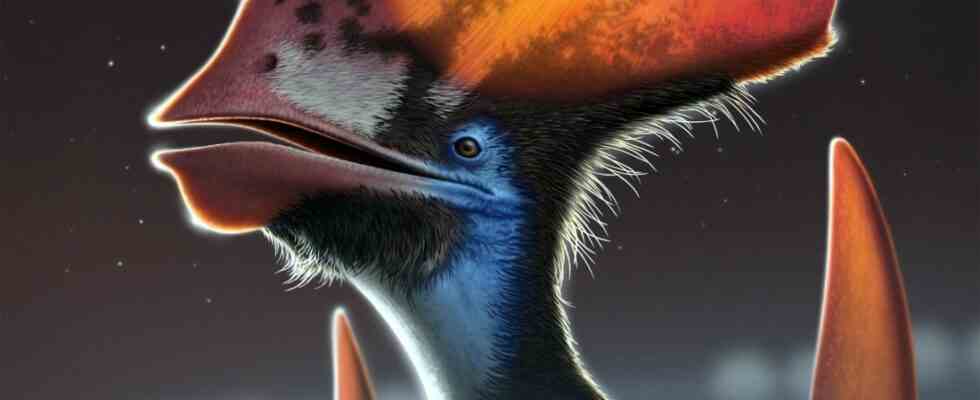It’s usually quite simple: Birds have feathers, other creatures don’t. But that only applies to the present. Because even a few dinosaurs and pterosaurs probably had feathers. The extent to which this is true has long been the subject of controversy among scientists. A study in the journal Nature now not only confirms that the extinct reptiles had feathers, but also indicates that those feathers were likely colorful.
For this study, the research team led by paleobiologist Aude Cincotta from University College Cork in Ireland looked at the soft tissue of the skull of a Tupandactylus imperator, which is said to have lived around 113 million years ago. The animal had a wingspan of five meters, a large, light head and belonged to the pterosaurs. These pterosaurs are close relatives of land-dwelling dinosaurs. In their analysis, the researchers were able to detect small whiskers, so-called monofilaments, and branched feathers, where in turn different melanosomes could be found. These are special organelles that produce the pigment melanin. In living beings, melanin is responsible for the coloring of skin, eyes and hair. The examination thus showed that the animals had colored feathers on their heads.
Even the ancestors of the dinosaurs could have decorated feathers
Previous research has shown that the pterosaurs had short-haired down that served as thermal insulation. So far, however, only uniform melanosomes had been found, suggesting that the coloration of the feathers was limited. Therefore, it was believed that these feathers only served to insulate heat. The discovery of different melanosomes on a fossil suggests that the feathers were different colors, according to the researchers. This sheds new light on the task of dinosaur plumage. In addition to the warming function, the feathers could also have had a signaling effect for conspecifics, for example for mating or communication. However, the feathers played no role in flying, the feathers were too small for that, they were more like a drain brush in shape. Instead, pterosaurs used membranes attached to their wings to take off.
The colorful discovery also sheds new light on the evolutionary history of feathers. Since the discovery of the first Archeopteryx, there has been debate as to when these came about. The so-called primeval bird was discovered in 1861 in the Franconian Jura and was the earliest evidence of feathers in a vertebrate. Archeopteryx lived around 150 million years ago in what is now Germany.
With the current results, the research team pushes the point in time at which feathers formed much further into the past. Because based on the finds, the paleontologists conclude that feathers already adorned the Avemetatarsalia, the common ancestors of pterosaurs and dinosaurs. These lived around 250 million years before our time and thus 100 million years before Archeopteryx. It is also conceivable “that feathers evolved independently in several groups of dinosaurs and in pterosaurs,” writes paleontologist Michael Benton of the University of Bristol in an accompanying commentary Nature. Similarities in the structures of the pigments as well as genetic and developmental characteristics made a common origin more likely.

